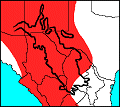

This species is a colonial animal preferring to congregate and roost in caves, abandoned mine tunnels, and buildings (Schmidly 1977). It is primarily an inhabitant of desert regions, where it is most commonly encountered in lowland habitats near open water, being more closely associated with water than any other North American species (Schmidly 1977). In the Big Bend region of Texas, it is common in summer along the Rio Grande, where it comes to drink along cottonwood-lined areas (Tuttle 2003). When in flight, it flutters and is erratic, a common characteristic of other members of the genus (Davis and Schmidly 1994). There are no winter records are available for Texas, and it is uncertain whether the Yuma Myotis migrates or overwinters in the state during this season (Davis and Schmidly 1994).
Davis, W. B., and D. J. Schmidly. 1994. The mammals of Texas. Texas Parks and Wildlife Press, Austin.
Schmidly, D. J. 1977. The mammals of Trans-Pecos Texas including Big Bend National Park and Guadalupe Mountains National Park. Texas A&M University Press, College Station.
Tuttle, M. D. 2003. Texas bats. Bat Conservation International, Inc., Austin.
A. Ruth Huckaby, Graduate Student, BIOL 5301-Natural History of the Chihuahuan Desert, June, 2006.
Huckaby Update: 22 June 2006
Last Update: 24 Jul 2009